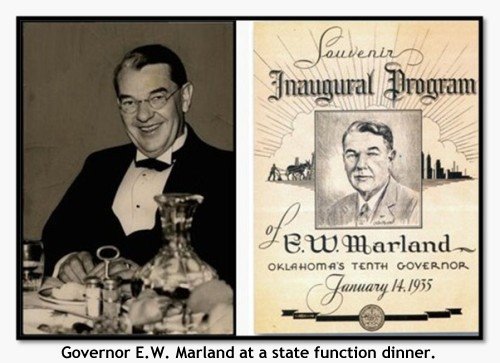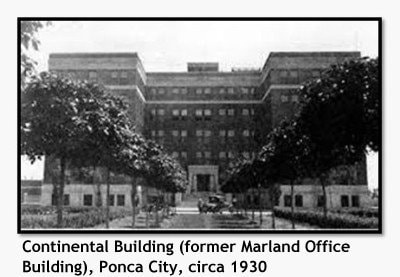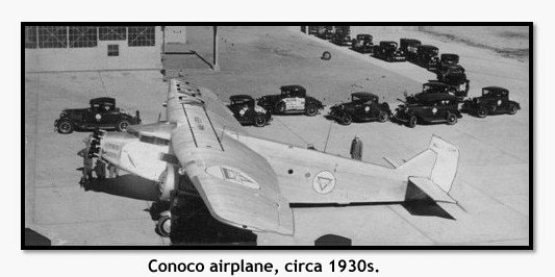1930-1940
Between the years of 1925 to 1928, E.W. Marland was building a lavish European palace on the prairie of Oklahoma only a mile away as the bird files from his current estate on Grand Avenue. On July 14, 1928, two years after the death of his first wife, Mary Virginia, E.W. Marland married his adopted niece, Lydie. At the time Marland was 54 years old, and Lydie was 28. The Marlands moved into “The Refuge,” as it was known in the day, in October of the same year. Marland now owned two homes, the former mansion on Grand Avenue and the larger fifty-five room estate. Marland’s stately new home and its elegant outbuildings were located northeast of Ponca City on acres of wooded ground secured as a refuge for wildlife with lakes, ponds, and grain fields. Mrs. I. M. (Ignatia) Rittenhouse, one of E.W. Marland’s two sisters, occupied the former Grand Avenue home following the Marlands’ move into the larger estate at 901 Monument Road. The other Marland sister, Charlotte, lived diagonally across the street just northwest from the mansion on Grand.
pioneer woman statue site
After its completion, the site of the address on Grand was to eventually become the new home for Marland’s commissioned Pioneer Woman Statue. Before losing his oil company and after the building of the Refuge had begun, Marland had planned to raze the home at 1000 E. Grand Avenue making room to place the Pioneer Woman Statue in its place. She would gaze forward to the east toward the Osage Hills in the distance. Marland was to include the expansive formal gardens and endow the park in which the statue would be placed turning it over to the public or would make it a national park.
politics ahead
After the break-away of E.W. Marland from Marland Oil, the stock market crash and Great Depression took hold and prevented Marland from starting a new oil company as he had hoped. The remaining funds he did have in his accounts were of much less value now and contained much less overall buying power. Changing careers, Marland decided to run for U.S. Representative to Congress and was elected in 1932. He served for two years in Washington D.C., but decided not to re-up for a second term. Instead he chose to run for governor of the state partnering with F.D.R. on the New Deal plan. He was inaugurated in January of 1935 as Oklahoma’s 10th governor. In both positions his democratic influence contributed greatly to the welfare of the people of the state during a very trying time.
dan moran arrives from new york
An engineer by training, Daniel J. Moran, was appointed to fill Marland’s shoes at Marland Oil. Moran moved from New York City, where he had been four years as vice-president of the Texas Corporation of Standard Oil, to Ponca City and into the large white stucco home. Prior to the transfer, Moran worked out of both New York and Houston offices and had ties to J.P. Morgan, Jr., Marland’s former banker. Moran assumed the position of president of the Marland Oil Company, soon to be renamed Continental Oil Company, after the merger of Marland Oil and Continental of Colorado a year later.
marland sells property to moran
Moran’s wife, Carolyn, and children, Daniel James Jr. and Frances Marie occupied the site. After renting the home to Moran during Moran’s first year of office as president of the company, Marland sold him the property in 1930. The sale included the home, carriage house, and two lily ponds with a large yard area. The remaining infamous Marland Gardens to the east were not a part of the transaction. Mrs. Moran continued to host the popular Ponca City Music Club in the home as Mrs. Marland had done the decade before.
moran interested in architecture
Moran’s tough ways assisted the newly blended oil company to survive in an age of greater competition becoming a leaner more streamlined company poised for broad-based petroleum production. While at CONOCO in Ponca City, Moran constructed the cafeteria and swimming pool buildings for the CONOCO campus to benefit the employees. In 1935 Moran also purchased a large cattle and sheep ranch close to Kerrville, Texas, along the Guadeloupe River which had been owned by two wealthy Texas millionaires, O.R. Seagraves and W.W. Wilson. The ranch, which he named “Mo-Ranch,” had a large Spanish styled house which the Moran family visited on holidays and lived in through the summer months. Moran then added other buildings of native stone to the grounds.
“Moran was interested in architecture and designed a number of the structures that would eventually be added to the ranch facilities. Most of these were made of native store, and the gym and lodge bore a remarkable likeness to the old recreational building designed by Moran at the CONOCO Complex in Ponca City,” stated Louise Abercrombie in a Ponca City News article published in April of 1984.
“Moran was interested in architecture and designed a number of the structures that would eventually be added to the ranch facilities. Most of these were made of native store, and the gym and lodge bore a remarkable likeness to the old recreational building designed by Moran at the CONOCO Complex in Ponca City,” stated Louise Abercrombie in a Ponca City News article published in April of 1984.
moran leaves the oil business
Moran worked at CONOCO from 1929 to 1947 when he retired and moved to Mo-Ranch to spend his final years. Unfortunately, however, Moran died a year later. The Morans had lived at 1000 East Grand Avenue until 1940 when the property was sold to the J.G. Paris family. One thousand East Grand Avenue was now facing a new decade out from the oil business and into the private sector. The Paris family owned a local and successful furniture store. The home was about to gain some exquisite new furnishings…






